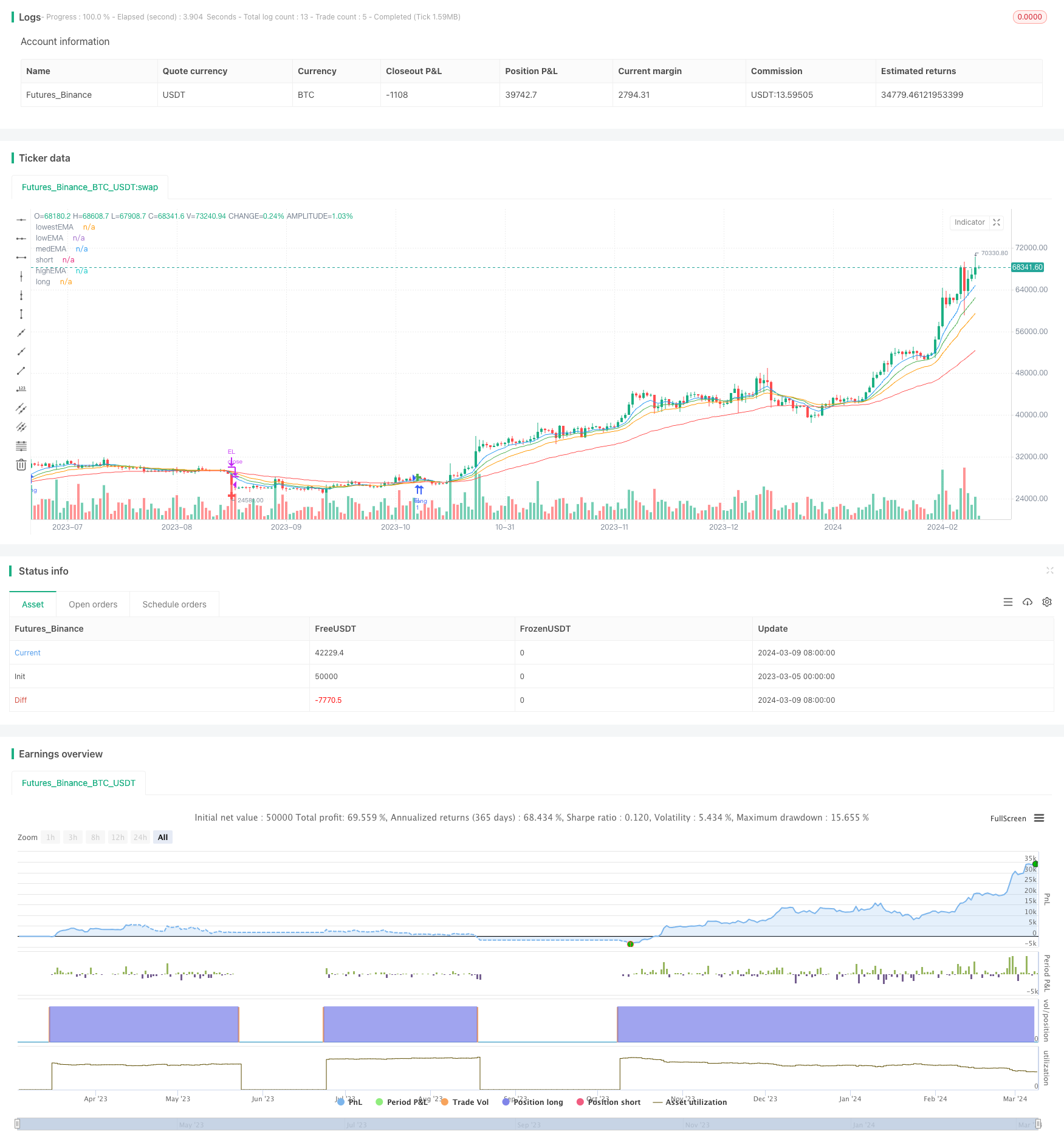
概述(Overview)
该策略综合利用了多条指数移动平均线(Exponential Moving Average, EMA)来识别潜在的市场交易入场点和出场点。通过比较不同周期的EMA走势,判断当前市场趋势,在趋势形成初期介入交易,趋势结束初期平仓。
策略原理(Strategy Principle)
该策略使用了4条不同周期的EMA作为核心指标,分别为超短期EMA(默认8期)、短期EMA(默认13期)、中期EMA(默认21期)和长期EMA(默认55期)。当长期EMA位于其他三条EMA下方时,判断当前可能处于上升趋势初期,此时策略开多仓;当长期EMA位于其他三条EMA上方时,判断当前可能处于下降趋势初期,此时策略平掉所有多仓。通过EMA的这种多空排列组合来识别趋势转折点,捕捉初生趋势。
EMA相比简单移动平均线(SMA)更加重视近期价格,因此EMA走势更灵敏,能更快速地反应价格变化。不同周期EMA的交叉情况则反映了不同时间尺度下的趋势强弱。长期EMA是最稳健的,代表大的市场趋势;中短期EMA相对灵敏,反映市场中短期趋势。它们共同构成了该策略的核心逻辑。
优势分析(Advantage Analysis)
适用性广:该策略基于价格本身的EMA指标,适用于多数流动性好、走势相对光滑的品种,如各类期货、外汇、主流数字货币等。
趋势跟踪:通过比较不同周期EMA的位置关系来判断趋势,一定程度上能捕捉趋势形成初期,跟踪趋势。
参数灵活:EMA的周期参数可以根据品种特点、Investment Horizon等灵活调整,具有一定的适应性。
逻辑清晰:策略基于简单的EMA多空排列组合产生交易信号,逻辑清晰明了,容易理解和实现。
风险分析(Risk Analysis)
EMA延迟:EMA本质上是一种趋势跟踪指标,存在一定的延迟性,在震荡市可能会发生较多虚假信号。
参数敏感:EMA周期参数的选择对策略表现有较大影响,并且参数优化后未必能在样本外数据上保持良好表现。
缺乏过滤:该策略缺乏对交易信号的进一步过滤,全部信号生成后都会进行交易,可能会发生一些低质量交易。
固定仓位:目前策略每次开仓都是固定1个单位,缺乏基于风险的动态仓位控制,风险管理方面不够完善。
优化方向(Optimization Direction)
引入趋势过滤:在EMA信号基础上,增加ATR、ADX等趋势强度过滤指标,过滤掉弱趋势和震荡期的信号。
引入波动率过滤:在趋势过滤基础上,可进一步引入波动率过滤,如布林带宽度等,过滤掉高波动率可能导致的低质量信号。
优化止损:目前策略缺乏明确的止损逻辑,可以在引入趋势和波动率过滤后,增加基于ATR或百分比的动态止损,控制单笔最大亏损。
动态仓位:可以基于品种波动率、账户价值比例等,对策略每次开仓的数量进行动态控制,在降低风险的同时追求更高的绝对收益。
优化参数:不同品种、不同周期,EMA的最优参数可能不同,需要根据品种特点分别进行参数寻优,提高策略的适用性。
总结(Summary)
该策略通过比较4条不同周期EMA的多空排列组合来识别趋势转折点,捕捉趋势形成初期,思路简单清晰。它的优势在于适用范围广、逻辑清晰、参数灵活,能较好地跟踪趋势;但同时也存在EMA指标固有的延迟性,以及参数敏感、缺乏过滤、固定仓位等问题。未来可以从引入趋势和波动率过滤、优化止损、动态仓位、参数优化等方面来提高该策略的稳健性和盈利能力,使其更加完善和可靠。
/*backtest
start: 2023-03-05 00:00:00
end: 2024-03-10 00:00:00
period: 1d
basePeriod: 1h
exchanges: [{"eid":"Futures_Binance","currency":"BTC_USDT"}]
*/
// This Pine Script™ code is subject to the terms of the Mozilla Public License 2.0 at https://mozilla.org/MPL/2.0/
// © n1ghthawk
//@version=5
strategy("donmo's 4ema", overlay=true, margin_long=100, margin_short=100)
float long = na
float short = na
lowestEMAPeriodInput = input.int(8, "Lowest EMA")
lowEMAPeriodInput = input.int(13, "Low EMA")
medEMAPeriodInput = input.int(21, "Med EMA")
highEMAPeriodInput = input.int(55, "High EMA")
lowestEMA = ta.ema(close, lowestEMAPeriodInput)
lowEMA = ta.ema(close, lowEMAPeriodInput)
medEMA = ta.ema(close, medEMAPeriodInput)
highEMA = ta.ema(close, highEMAPeriodInput)
emaLongCondition = highEMA<medEMA and highEMA<lowEMA and highEMA<lowestEMA
emaShortCondition = highEMA>medEMA and highEMA>lowEMA and highEMA>lowestEMA
longCondition = ta.change(emaLongCondition)
shortCondition = ta.change(emaShortCondition)
notInTrade = strategy.position_size <= 0
if longCondition and emaLongCondition and notInTrade
long:=high
strategy.entry("EL", strategy.long)
if shortCondition and emaShortCondition
short:=low
strategy.close("EL")
plot(long+3,title = 'long', color = color.green, linewidth = 4, style = plot.style_cross)
plot(short-3,title = 'short', color = color.red, linewidth = 4, style = plot.style_cross)
plot(lowestEMA, title = "lowestEMA", color=color.blue)
plot(lowEMA, title = "lowEMA", color=color.green)
plot(medEMA, title = "medEMA", color=color.orange)
plot(highEMA, title = "highEMA", color=color.red)